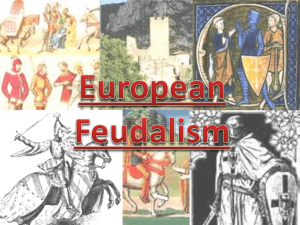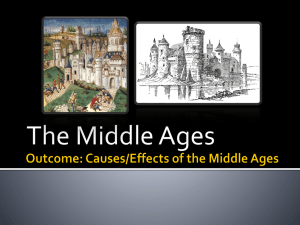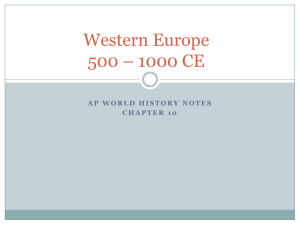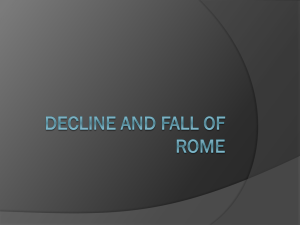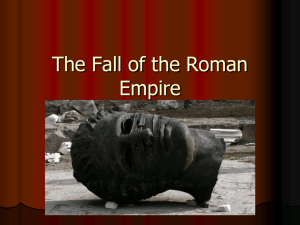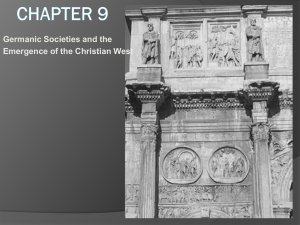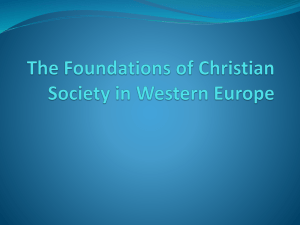The Barbarian Invasions
advertisement
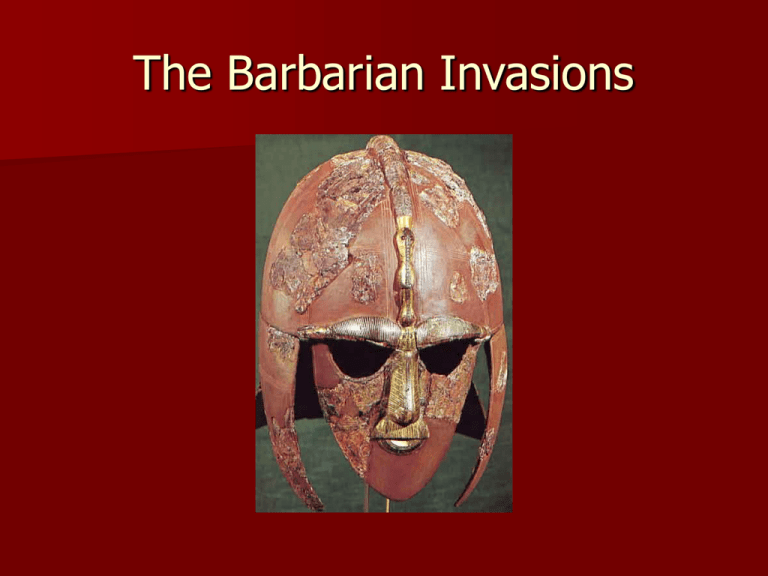
The Barbarian Invasions Content Goals and Objectives: Goal 4 – Barbarian Invasions The student will evaluate the invasions of Europe as a force for change in medieval Europe. – 4.01 Trace and evaluate the effects of the Germanic invasions during late antiquity including but not limited to the invasions of the Goths, Huns, Lombards, and Franks. – 4.02 Outline the political achievements and developments of the Merovingians in early medieval Europe. – 4.03 Evaluate the political developments and impact of the Carolingian Empire on medieval Europe. – 4.04 Detail the Vikings invasions and assess their impact on the cultural and political development of medieval Europe. – 4.05 Evaluate the role of the Islamic threat on the cultural and political developments of medieval Europe. – 4.06 Summarize the influence of Magyar invasions on cultural and political developments of medieval Europe. – 4.07 Assess the cultural and political results of the invasions of early medieval Europe. The Fall of the Roman Empire Beginning of the Middle Ages Invasions End of the Roman emperors The Fall of the Roman Empire continued What has been referred to as the fall of the Roman Empire marked the beginning of the Medieval era, and it also contributed to the social and political climate of Europe for centuries afterwards. Historians note that the Roman Empire, especially the city of Rome, fell for multiple reasons; however, one of the most significant reasons was the invasion of barbarian tribes. Rome was under constant threat of invasion from all sides, including Germanic tribes from north-central Europe, the Huns from Asia, and African tribes in the south. Several barbarian tribes eventually did attack, particularly in the west. Germanic invaders from the north took lands as far south as Greece and Gaul (France). Rome itself was sacked by Visigoths in 410, the Vandals in 455, and finally, in 476, Germanic invaders overthrew the last of the Roman emperors. The Barbarian Invasions Europe in 814 From Asia: Huns and Magyars From the Germanic north: Saxons, Angles, and Goths The Barbarian Invasions continued The founders of Europe’s future nations settled in the European mainland during the early medieval period. Invaders from Asia (namely the Huns and the Magyars) and German tribes (like the Saxons, Angles, and Goths) became less nomadic and created permanent settlements. Although many of the kingdoms created were short-lived and unstable, they marked a new era of European development for population centers away from Rome. Rise of the Germanic Peoples – Ostrogoths: Italian peninsula – Visigoths: modernday Spain – Angles and Saxons: modern-day Britain – Franks: central Europe “Invasion of the Goths into the Roman Empire,” a 19th-century painting Rise of the Germanic Peoples continued After the Germanic invasions, Roman influence merged with the Germanic culture and people in different ways. The Ostrogoths (in the Italian peninsula) preserved Roman governmental structure and traditions. The Visigoths, located in modern-day Spain, kept Roman traditions but installed Germanic leaders. In the British Isles, the Angles and Saxons each carved out portions to create their own kingdoms. The strongest of Germanic tribes was the Franks, located in central Europe, who gained much of their strength under Clovis and Charlemagne. Clovis (466–511) Established a Frankish kingdom in central Europe Conquered many competing tribes and regional Roman political leaders Converted to Christianity Clovis continued In 486, the Franks defeated the last major Roman army in Gaul (present-day France) then subdued other tribes and minor rulers in the area to establish the first Frankish Kingdom. Clovis, the first Frankish king, had a brilliant military career and dramatically expanded the holdings of his empire through battles with both competing tribes and remaining regional Roman political leaders. During his reign, he converted to Christianity— supposedly after praying to Jesus during a battle. This helped to establish bonds with Christians now under his rule through military conquest. Frankish Kingdom continued After the death of Clovis, Charles Martel became leader of the Franks. He continued to expand and defend the Frankish Kingdom, including the defeat of Muslim invaders in 732. After his death, his son, Pepin, asked the head of the church, Pope Zacharias, to recognize him as king. The pope agreed and Pepin became the first Frankish king to rule with papal blessing. Pepin ruled until 768. His successor, Charles, continued the relationship between the Frankish kingdom and the church and expanded it further. Charlemagne (742–814) Powerful leader, strong Christian Created the Carolingian Empire Crowned by Pope Leo III as the first Holy Roman Emperor Charlemagne continued Pepin’s son, Charles, became leader of the largest empire since the Romans. Known as Charlemagne (Charles the Great), he was another fierce military leader who sought to expand the Frankish empire. The vast new territory that he created became known as the Carolingian Empire. During his rise to power, Charlemagne was summoned by Pope Leo III, who crowned him the Emperor of the Romans (or Holy Roman Emperor), uniting the Roman, Christian, and Germanic cultures and traditions. Conquests of Charlemagne continued Charlemagne defeated the Lombards to the south, the Saxons to the north, and the Slavs to the east. After Charlemagne’s death, his empire quickly fell apart as his grandsons fought one another for control. Powerful local nobles came to control land interests throughout Europe, leading to a decentralization of power. Adding to the disorder were constant raids carried out by Scandinavian warriors known as Vikings. The Vikings Warrior culture from Scandinavia Raided Europe Established settlements throughout Europe and even in North America A Viking longboat The Vikings continued The Vikings were a warrior culture from Scandinavia, hailing from the areas we now know as Denmark, Sweden, and Norway. Scholars disagree about the reasons why the Vikings began to aggressively raid other cultures and settle their lands. Overcrowding in the Viking homelands may have forced them to seek new territory; crop failures or a desire to find new trade outlets may also have been factors. Viking settlers ended up as far south as the Mediterranean, as far East as modern-day Russia, and as far west as modern-day Iceland, Greenland, and even Canada. They overran a large area of northwestern France and called it Norsemanland, later known as Normandy. Viking Invasions continued Charlemagne’s heirs had difficulty maintaining law and order in the kingdom’s fragmented territories, and the Vikings gained footholds in many areas of the Carolingian Empire. Though they had success in the 9th century venturing into the European mainland, the Vikings eventually lost their edge as the growing kingdoms of Europe developed new, more effective ways to organize and defend themselves. Feudalism A French vassal receiving a feudal grant from the king A political, economic, and social system in which land was allocated in exchange for services; roles and obligations were clearly defined for all participants Grew out of Roman practices of clientage/patronage Originally developed as a means of protection and defense Feudalism continued Feudalism developed out of peoples’ need for protection against invaders and landowners’ need to defend their property. The feudal system grew out of the practices of “clientage” or “patronage” which had existed under the Roman Empire; these practices involved smaller landowners placing themselves under the protection of larger landowners, usually in exchange for payment or goods. In medieval feudalism, individual monarchs throughout Europe were unable to afford protection of their empires, so they gave trusted soldiers parcels of land in exchange for their promise to defend it and make it useful. Feudalism appeared in Europe during the 700s in the areas we know now as France and Germany, as weak governments sought solutions to the question of how to provide security with limited resources. By the 1000s, most of western Europe practiced some form of feudalism. Roles in the Feudal System Lord Vassal Fief Manor Serf Feudal serfs Roles continued Lord—A landowner, usually a noble, although sometimes lords were bishops Vassal—A person (usually a soldier) given a piece of land by the lord Fief—The land itself that is given Manor (sometimes referred to in the context of the “manorial system”)—A basic unit of land, usually big enough for the supervision of a single noble or knight Serf—Though it technically translates as “slave,” the word “serf” (often used interchangeably with “peasant”) refers to a worker on the lord’s manor. Though not truly slaves, serfs had no legal rights and were compelled to work on their assigned land. The Feudal Power Relationship Monarch Nobles Lesser Nobles/Knights Peasants Feudal Power continued In most European feudal relationships, a power structure evolved that remained intact for several centuries. At the top of the power pyramid was the monarch, who granted autonomous control over different parts of the kingdom to nobles. These nobles became “vassals” of the monarch, and in exchange for land, each vassal swore an oath of “fealty” or loyalty to the monarch. Although the nobles were powerful, they often subdivided their land grants to lesser nobles or knights who then became the vassals of the noble in much the same capacity as the nobles served the monarch. The vast majority of people in the feudal system were peasants—very poor individuals who were responsible for tending the land. All of these relationships were based on exchange: the monarch granted land in exchange for management, the nobles granted land and protection in exchange for goods, and the lesser nobles granted protection in exchange for goods. All levels of society were bound by loyalty to the level above them. Knights Elite military soldiers Usually from the noble classes Stages of training: page, squire, knight Chivalry Statue of a medieval knight Knights continued Knights tended to be vassals of nobles. In exchange for land, they would swear an oath of fealty to the noble and agree to fight for them and protect them. Horses, heavy armor, and weapons were expensive, which meant that elite warriors usually came from the noble classes or were financed by them. There were two types of soldiers in feudal Europe: common foot soldiers (usually peasants forced into service) and knights—the elite warriors. A knight’s training was rigorous and took a great deal of time: boys were often chosen to be knights early in life so that training could begin. Milestones in a knight’s life were as follows: – Age 7: served as a “page,” an attendant in the personal service of an individual knight; given basic lessons in horsemanship and basic hand-to-hand fighting skills – Age 14: successful students would be granted the title of “squire,” which included sword privileges and increasingly difficult physical challenges and tasks such as assisting a knight in battle – Age 21: formally qualified to become a knight – Knighthood could be achieved in one of two ways: usually, a squire would be knighted as a rite of passage at the end of his training; however, he could also be granted knighthood after a particular act of bravery. Knights were supposed to live by a code of behavior known as chivalry, which required them to remain loyal to their lords, fight with honor, treat all with justice, and act politely towards women. Although chivalry has often been celebrated and idealized in literature and popular imagination, many historians note that it wasn’t universally practiced and its rules were often ignored. The Medieval Tournament Means of practicing military skills Tournaments continued Knights practiced their military skills in exercises known as “tournaments”—mock battles that involved both real weapons and actual combat (though some tournaments outlawed points on swords). Tournaments ranged from small affairs with a handful of knights to grand, staged affairs played out in front of large audiences. Rules varied throughout the ages, but as tournaments became more violent, the various monarchs of Europe sought to limit—or, in some cases, to ban—the practice. Another popular sport in late medieval Europe was jousting, which involved two knights charging each other on horseback and attempting to dismount one another. Castles Centers of noble life Purposes: – Intimidation – Military defense – Residence Warwick Castle, England Castles continued Castles were centers of life for nobles and knights, serving as homes and fortresses. Building a castle was often a lifelong pursuit for nobles; some castles would even take several generations to complete. Castles were usually constructed by serfs and masons (craftsmen who worked with stone). Once erected, these buildings would serve a number of purposes: Intimidation—Castles were often built in the spirit of competition with other nobles, friendly or otherwise. A large castle could serve as a sign of a noble’s strength, esteem, or power. Castles were often placed on the highest point in a region so they could be seen from great distances. Military defense—Castles were most certainly built with military use in mind. They had clever defensive designs, incorporating elements such as moats, large watchtowers, and high walls. Castles were sometimes built on the outer regions of a noble’s land grant as a means of encroaching on another noble’s territory. Residence—Nobles and their families lived in castles. The castles of the higher nobles were often lavishly decorated, with rich tapestries on the walls, grand halls, and music rooms. Castles were dark, lit only by torches and fireplaces. The rooms were large and drafty because windows did not have glass in them.

